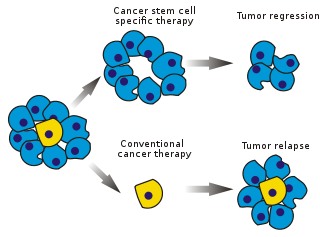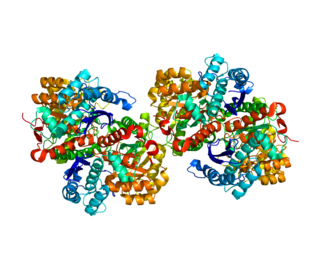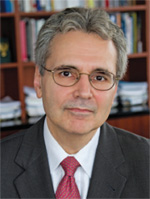
Bcl-2, encoded in humans by the BCL2 gene, is the founding member of the Bcl-2 family of regulator proteins that regulate cell death (apoptosis), by either inhibiting (anti-apoptotic) or inducing (pro-apoptotic) apoptosis.
James Edgar Till, is a University of Toronto biophysicist, best known for demonstrating – with Ernest McCulloch – the existence of stem cells.

Cancer stem cells (CSCs) are cancer cells that possess characteristics associated with normal stem cells, specifically the ability to give rise to all cell types found in a particular cancer sample. CSCs are therefore tumorigenic (tumor-forming), perhaps in contrast to other non-tumorigenic cancer cells. CSCs may generate tumors through the stem cell processes of self-renewal and differentiation into multiple cell types. Such cells are hypothesized to persist in tumors as a distinct population and cause relapse and metastasis by giving rise to new tumors. Therefore, development of specific therapies targeted at CSCs holds hope for improvement of survival and quality of life of cancer patients, especially for patients with metastatic disease.
The epithelial–mesenchymal transition (EMT) is a process by which epithelial cells lose their cell polarity and cell-cell adhesion, and gain migratory and invasive properties to become mesenchymal stem cells; these are multipotent stromal cells that can differentiate into a variety of cell types. EMT is essential for numerous developmental processes including mesoderm formation and neural tube formation. EMT has also been shown to occur in wound healing, in organ fibrosis and in the initiation of metastasis in cancer progression.

Smoothened is a protein that in humans is encoded by the SMO gene. Smoothened is a Class Frizzled G protein-coupled receptor that is a component of the hedgehog signaling pathway and is conserved from flies to humans. It is the molecular target of the natural teratogen cyclopamine. It also is the target of Vismodegib, the first hedgehog pathway inhibitor to be approved by the U.S. Food and Drug Administration (FDA).

Mothers against decapentaplegic homolog 7 or SMAD7 is a protein that in humans is encoded by the SMAD7 gene.

Oncogenomics is a sub-field of genomics that characterizes cancer-associated genes. It focuses on genomic, epigenomic and transcript alterations in cancer.
The Cancer Genome Atlas (TCGA) is a project, begun in 2005, to catalogue genetic mutations responsible for cancer, using genome sequencing and bioinformatics. TCGA applies high-throughput genome analysis techniques to improve our ability to diagnose, treat, and prevent cancer through a better understanding of the genetic basis of this disease.

Enolase 1 (ENO1), more commonly known as alpha-enolase, is a glycolytic enzyme expressed in most tissues, one of the isozymes of enolase. Each isoenzyme is a homodimer composed of 2 alpha, 2 gamma, or 2 beta subunits, and functions as a glycolytic enzyme. Alpha-enolase, in addition, functions as a structural lens protein (tau-crystallin) in the monomeric form. Alternative splicing of this gene results in a shorter isoform that has been shown to bind to the c-myc promoter and function as a tumor suppressor. Several pseudogenes have been identified, including one on the long arm of chromosome 1. Alpha-enolase has also been identified as an autoantigen in Hashimoto encephalopathy.

Cyclin D1 is a protein that in humans is encoded by the CCND1 gene.

MAX is a gene that in humans encodes the MAX transcription factor.

E3 ubiquitin-protein ligase RING2 is an enzyme that in humans is encoded by the RNF2 gene.

Partner and localizer of BRCA2, also known as PALB2 or FANCN, is a protein which in humans is encoded by the PALB2 gene.

Whole genome sequencing is ostensibly the process of determining the complete DNA sequence of an organism's genome at a single time. This entails sequencing all of an organism's chromosomal DNA as well as DNA contained in the mitochondria and, for plants, in the chloroplast. In practice, genome sequences that are nearly complete are also called whole genome sequences.

Regulatory factor X, 6 also known as DNA-binding protein RFX6 is a protein that in humans is encoded by the RFX6 gene.
Tumour heterogeneity describes the observation that different tumour cells can show distinct morphological and phenotypic profiles, including cellular morphology, gene expression, metabolism, motility, proliferation, and metastatic potential. This phenomenon occurs both between tumours and within tumours. A minimal level of intra-tumour heterogeneity is a simple consequence of the imperfection of DNA replication: whenever a cell divides, a few mutations are acquired—leading to a diverse population of cancer cells. The heterogeneity of cancer cells introduces significant challenges in designing effective treatment strategies. However, research into understanding and characterizing heterogeneity can allow for a better understanding of the causes and progression of disease. In turn, this has the potential to guide the creation of more refined treatment strategies that incorporate knowledge of heterogeneity to yield higher efficacy.

Multiomics, multi-omics or integrative omics is a biological analysis approach in which the data sets are multiple "omes", such as the genome, proteome, transcriptome, epigenome, and microbiome; in other words, the use of multiple omics technologies to study life in a concerted way. By combining these "omes", scientists can analyze complex biological big data to find novel associations between biological entities, pinpoint relevant biomarkers and build elaborate markers of disease and physiology. In so doing, multiomics integrates diverse omics data to find a coherently matching geno-pheno-envirotype relationship or association. The OmicTools service lists more than 99 softwares related to multiomic datanalysis, as well as more than 99 databases on the topic.

Sir Andrew James McMichael, is an immunologist, Professor of Molecular Medicine, and previously Director of the Weatherall Institute of Molecular Medicine at the University of Oxford. He is particularly known for his work on T cell responses to viral infections such as influenza and HIV.

Ana Maria Cuervo is a Spanish-American physician, researcher, and cell biologist. She is a Professor in Developmental and Molecular Biology, Anatomy and Structural Biology, and Medicine and co-director of the Institute for Aging Studies at the Albert Einstein College of Medicine. She is best known for her research work on autophagy, the process by which cells recycle waste products, and its changes in aging and age-related diseases.

Yi Zhang is a Chinese-American biochemist who specializes in the fields of epigenetics, chromatin, and developmental reprogramming. He is a Fred Rosen Professor of Pediatrics and Professor of Genetics at Harvard Medical School, a Senior Investigator of Program in Cellular and Molecular Medicine at Boston Children's Hospital, and an Investigator of the Howard Hughes Medical Institute. He is also an Associate Member of the Harvard Stem Cell Institute, as well as the Broad Institute of MIT and Harvard. He is best known for his discovery of several classes of epigenetic enzymes and the identification of epigenetic barriers of SCNT cloning.




















